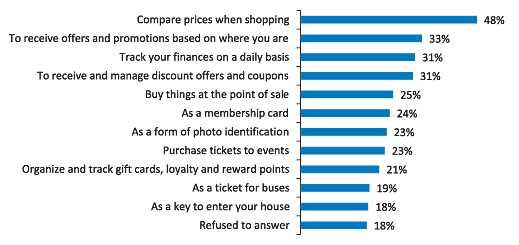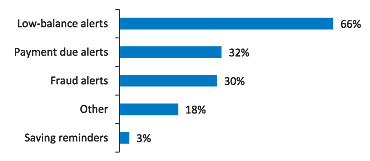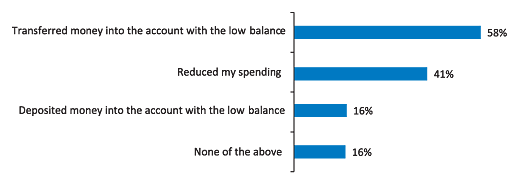Consumers and Mobile Financial Services
March 2012
- How Are Consumers Interacting with Financial Institutions?
- Current Use of Mobile Banking and Payments
- Other Mobile Financial Services
Other Mobile Financial Services
In this Section:
There appears to be widespread interest among mobile phone users in expanding how they use mobile technology to access financial services, despite the Federal Reserve survey finding that only 21 percent of respondent mobile phone users have adopted mobile banking and only 12 percent of respondents have adopted mobile payments.
Consumers were asked to select the types of activity they would be interested in performing with their mobile phones assuming the function were made available to them (figure 5). Nearly one-half (48 percent) of consumers in the survey express an interest in using their phone to compare prices while shopping. Similarly, one-third indicate that they would like to use their mobile phones to receive location-based offers and promotions, and 31 percent indicate that they would like to receive and manage discount offers and coupons. Consumers also report that they would use their mobile phones to manage their personal finances, as 31 percent indicate that they would like to use their mobile phones to track their finances on a daily basis.
Consumers in the survey have a limited interest in using their mobile phone as a "mobile wallet": 25 percent indicate they would like to use their mobile phone to pay at the point of sale. Given the current mobile payment adoption rate of 12 percent, this would double the use of mobile payments. One fourth indicate they would use it as a membership card, and 21 percent indicate they would use it to organize and track gift cards, loyalty points, and reward points. In a related potential application of mobile technology, 23 percent of consumers indicate that they would like to use their mobile phones as a form of photo identification.

Note: This was question 46 in the survey (see Appendix 1); number of respondents was 2,002.
Shopping Behavior
The adoption of smartphones with barcode scanning software and Internet access has the potential to substantially alter consumer behavior in the retail environment. With this technology, consumers can quickly and easily compare prices across retailers while in store or online, or locate an item that is out of stock.
Consumers can also browse product reviews or get product specifications with little effort. Thus, consumers may become better informed about the products they purchase and find lower prices; however, the ease with which these tasks can be performed might also encourage impulse buying.
Consumers already make significant use of the Internet to inform their major purchases. A majority of respondents (58 percent) indicate that they comparison-shop online, and the same percentage say they look at product reviews before making a large purchase while at a retail store. Even though security concerns may make consumers wary of mobile devices as the payment mechanism for point-of-sale purchases, the technology can enable shopping and comparisons of products and services. About one in eight (16 percent) mobile phone users report using their mobile phone for online shopping, and nearly one-fifth of consumers with mobile phones (19 percent) say that they use their mobile phone to comparison shop while at a retail store.
Despite the relative novelty of barcode scanning applications, the Federal Reserve survey found that 12 percent of mobile phone users report using a barcode scanning application for price comparisons. One in six (16 percent) mobile phone users report using their mobile phone to browse online shopping reviews while in the store.
Many consumers who use their mobile phone to comparison-shop report that they altered their decisions as a result: 65 percent who have comparison-shopped in a store report that they changed where they made a purchase after comparing prices, and 77 percent report that they changed what they purchased as a result of reading product reviews on their mobile phone while at a retail store.
Meanwhile, as a growing number of retailers develop their capabilities in the mobile space, opportunities will arise for the use of mobile advertisements and offers. Thirty-seven percent of consumers in the survey report signing up for coupons or special offers by e-mail from retail stores in the past 12 months, and 73 percent of these consumers report having made a purchase as a result of these promotions. Moreover, 28 percent of all consumers report signing up with an online coupon or offer site such as Groupon or Living Social.
Personal Financial Management and Budgeting
Some consumers appear to be actively managing their finances using their computer and some form of personal financial management (PFM) tool. For the purposes of this survey, the Federal Reserve defined a PFM tool as a "program or website used to track your household finances (e.g., Quicken, Mint.com, Excel, or a website provided by a bank)." Slightly more than one in five consumers (21 percent) report that they, or someone in their household, use a program or website to track their household finances. Most consumers who track their finances are long-time users--42 percent report using the program or website for more than five years. The median consumer uses PFM tools about five times a month (just about once a week).
Access on a mobile phone to information about financial accounts has the potential to shape consumers' financial decisions. For example, 67 percent of mobile banking users report using their mobile phone to check account balances or available credit before making a large purchase in the past 12 months. Of those who checked their balance or available credit, 59 percent report that they decided not to buy an item because of the amount of money in their bank account or the amount of available credit.
Furthermore, some mobile phones not only allow their users to access financial accounts but also serve as PFM tools. For example, 7 percent of mobile phone users report using their mobile phone to track purchases and expenses. Among this group, 38 percent use a mobile application for expense tracking, 10 percent use a spreadsheet, 47 percent use the web browser to access a website, 12 percent send text messages, and 21 percent take notes in a notepad or word processor.
Consumers can take advantage of other financial management tools on their mobile phones, such as text alerts, to make smarter financial decisions. Alerts, reminders, and similar services provided by banks are meant to encourage positive consumer behaviors and, given the positive response to low-balance alerts, it seems that text message notices are an effective tool for encouraging consumers to engage in better financial behaviors.
One-third of mobile banking users indicate that they receive text message alerts from their bank and, out of this group, 66 percent receive "low-balance alerts" (figure 6). Nearly all report taking some action in response to getting a low-balance text alert from their bank: transferring money into the account with the low-balance (58 percent), reducing their spending (41 percent), or depositing additional money into the account (16 percent) (figure 7). Almost one-third of text message bankers (31 percent) indicate that they receive "payment due alerts," and 3 percent indicate that they receive "savings reminders."

Note: This was question 74 in the survey (see Appendix 1); number of respondents was 111.

Note: This was question 75 in the survey (see Appendix 1); number of respondents was 78.
Unbanked and Underbanked
As previously discussed, mobile technologies offer an opportunity to draw the unbanked and underbanked into the mainstream financial system by providing easily accessible and low-cost financial services.
Who Are the Unbanked and Underbanked?
For purposes of this report, an underbanked consumer is defined as a respondent who has a checking, savings, or money market account, but who also uses an alternative financial service such as auto title lending, payday loans, a check-cashing service, or a payroll card. An unbanked consumer is defined as someone who does not currently have a checking, savings, or money market account (see box 1).
Box 1. Alternatives to Traditional Banking and Financial Services
The survey included other questions on consumers' use of financial products, consumer financial behaviors, and consumer attitudes. Among those questions were ones on alternative financial services; results are reported here because of the general interest in these topics among consumer educators and community development professionals.
Over the past several decades, new financial products and services have arisen to meet the needs of consumers who may not have had their financial needs met by mainstream financial institutions, or who wanted an alternative to mainstream financial institutions.
The spreading availability and use of payday lenders, check cashers, and prepaid debit cards are prime examples of this trend.
These products and services charge fees and effective interest rates that, in some cases, can impose a significant burden on the finances of consumers and can be detrimental to consumers' long-term financial well-being.
Payday lenders typically charge consumers fees ranging from 15 to 20 percent of the loan amount for a two-week loan, which translates into an Annual Percentage Rate (APR) ranging from 390 percent to 520 percent.1
Among the various alternative financial products and services, use of prepaid cards is the most common in our sample--more than half (55 percent) of the respondents report using some type of prepaid card. About one out of seven respondents (15 percent) use a general purpose prepaid card, 5 percent have a government provided prepaid card, and 2 percent have a payroll card.
Why Consumers Use Payday Lenders
Eleven percent of respondents in our sample report that they or their partner/spouse have used a payday loan, but only 5 percent report having done so in the past 12 months. As shown in figure A, the main reasons for using payday loans or advances are perceptions that the borrower would not qualify for a bank loan or credit card (29 percent), that payday loans are easier to get than a bank loan or credit card (25 percent), and that payday loans are quicker to receive than other loans (18 percent). Few respondents indicate that the reason for using the payday lender is convenience (4 percent) or level of comfort with banks (1 percent).
Figure A. What was the main reason for using a payday loan or payday advance service rather than a bank loan or credit card? 
Accessible Version | Return to text
Note: This was question 6 in the survey (see Appendix 1); number of respondents was 223.
Besides payday lenders and prepaid cards, the use of the other types of alternative financial services was quite rare in our sample. Only 4 percent of the overall sample reports having used a check-cashing service, auto title loan, or layaway loan in the past 12 months.
The proportion of respondents who report being unbanked or underbanked in this survey closely tracks that found in previous national studies. In this study, about 11 percent of the U.S. adult population is currently unbanked, compared with approximately 8 percent according to the 2009 Federal Deposit Insurance Corporation (FDIC) National Survey of Unbanked and Underbanked Households and 8 percent according to the Federal Reserve's 2007 Survey of Consumer Finances (SCF).10
Results indicate that a further 11 percent of the U.S. population is underbanked. This rate is well below the 18 percent underbanked rate found in the FDIC study; however, the definition of underbanked here is more narrow than the FDIC's definition, as the latter includes use of services such as money orders when classifying an individual as underbanked.
Why Are Consumers Unbanked and Underbanked?
From this survey, the reasons reported for being unbanked largely mirror those found in the 2007 SCF. The most commonly cited reason is a general dislike of dealing with banks (24 percent) (figure 8). Meanwhile, 23 percent report that they do not write enough checks to justify owning an account, and 13 percent indicate that the fees and service charges on an account are too high. A further 10 percent of the unbanked report that banks would not allow them to open an account.
This order of response frequency for why consumers remain unbanked tracks that found in the 2007 SCF, and the magnitudes are nearly identical. For example, 25 percent of unbanked respondents to the SCF report that they do not have a checking account because they do not like dealing with banks, and 19 percent report that they don't write enough checks to make it worthwhile.

Note: This was question 3 in the survey (see Appendix 1); number of respondents was 200.
Mobile Device Use by the Unbanked and Underbanked
Although 11 percent of all individuals are unbanked, they are not necessarily "unphoned." Among individuals who are unbanked, 64 percent have access to a mobile phone and 18 percent have access to a smartphone. More remarkably, 91 percent of the underbanked have a mobile phone and 57 percent have a smartphone--rates far above those for the overall population.
The Unbanked and Mobile Banking
The utilization of mobile banking among the unbanked is low, with only 10 percent reporting its use in the past 12 months. Although the concept of an unbanked mobile banking user seems counterintuitive, 32 percent of unbanked individuals do, nevertheless, report using a debit card or check card in the past 12 months. Recall that our definition of mobile banking used here includes "using a mobile phone to access your bank account, credit card account, or other financial account[emphasis added]." Respondents may be referring to another financial account, such as a payroll card or prepaid card, often marketed as a "debit" card.
Additionally, 19 percent of the unbanked report using a general purpose prepaid card in the past 12 months, and 9 percent report using a major credit card in the past 12 months. Mobile payment adoption among the unbanked is 12 percent, which is approximately the same as in the overall population. Given the sample size of the survey, the number of individuals who are unbanked and use mobile financial services is fewer than 20, which prevents detailed analysis of their behavior.
The Underbanked and Mobile Financial Services
The underbanked population makes substantial use of mobile financial services. Almost 29 percent of the underbanked with mobile phones report using mobile banking in the past 12 months, while 17 percent report using mobile payments.
As with all other consumers, the primary use for mobile banking among the underbanked is to check account balances, with 89 percent utilizing this service. Overall, the underbanked use mobile banking for the same purposes as the general population, with only slightly lower rates for making bill payments (20 percent relative to 26 percent) and significantly higher rates for transferring money between their accounts (55 percent relative to 42 percent).
Although the underbanked are more likely than the general population to use mobile payments, the services that they use largely mirror those of the general population with one notable exception: the underbanked are substantially more likely to make bill payments using their mobile phones. Specifically, 62 percent of underbanked mobile payments users report paying bills, with their mobile phone in the past 12 months compared with 47 percent of the overall population of mobile phone users.
Conclusion
The evolution of mobile technology has the potential to empower consumers and expand access to financial services for previously underserved populations. The prevalence of mobile phone access among minorities, low-income individuals, and younger generations creates the possibility of using mobile technology to expand financial inclusion to previously underserved populations.
The disproportionate use of mobile bill payment by the underbanked found in our survey is one example of how this technology can improve financial access for these groups. Mobile banking is poised for significant growth in adoption in the near future, with usage likely increasing to one in three mobile phone users by early 2013. Similarly, a significant fraction of mobile phone users appears to be interested in using phones to make mobile payments.
Consumers' perception that mobile banking and mobile payments are unsecure is currently one of the primary impediments to adoption. If consumers' perception of security issues changes--whether due to actual or perceived improvements--adoption rates may significantly increase.
References
1. The Pew Research Center reports that 35 percent of American adults owned a smartphone as of May 2011. Pew Internet study, 2011, 35% of American Adults Own a Smartphone (PDF) ![]() . Return to text
. Return to text
10. Bucks, Brian K., Arthur B. Kennickell, Traci L. Mach and Kevin B. Moore, 2009, "Changes in U.S. Family Finances from 2004 to 2007: Evidence from the Survey of Consumer Finances," Federal Reserve Bulletin. Return to text
